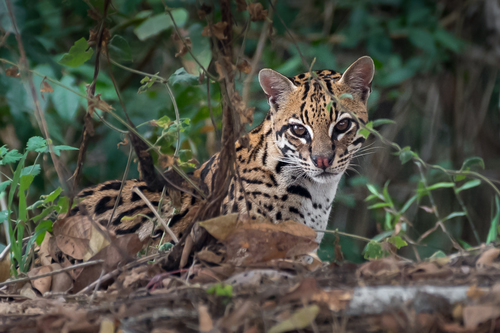
Ocelot
The ocelot, Leopardus pardalis, captivates with its stunning spotted coat and nocturnal prowess. Inhabiting lush jungles, it plays a vital role as a predator, maintaining balance in its ecosystem. Agile and elusive, this solitary feline is a master of stealth, both on land and in trees.
8-12 years
Lifespan
11.5 - 16.0 kg
Weight
Length: 55 - 100 cm
Size
Grey, Yellow, Red, Black, Tan
Color
2-3 years
Age of Sexual Maturity
6 weeks
Age of Weaning
38 mph
Top Speed
Least Concern
Conservation Status
Decreasing
Population Trend
Characteristics
The Leopardus pardalis, commonly known as the ocelot, is a medium-sized wild cat native to South and Central America. It has a striking coat marked with chain-like rosettes and spots. Ocelots are nocturnal, solitary animals, primarily inhabiting rainforests but also found in grasslands and mangroves. They are adept climbers and swimmers, preying on small mammals, birds, and reptiles.
Distribution Range of the Ocelot
Leopardus pardalis, commonly known as the ocelot, is native to the Americas. Its geographical distribution extends from the southern United States, particularly in Texas, through Mexico, Central America, and into South America, reaching as far south as northern Argentina and Uruguay. The species is widespread across countries such as Brazil, Venezuela, Colombia, and Peru.
Ocelot's Habitat
Environmental Conditions
The ocelot inhabits a range of environments, primarily favoring tropical and subtropical regions. It thrives in dense forests, including rainforests, tropical deciduous forests, and mangrove swamps. However, it can also be found in savannahs, thorn scrubs, and semi-arid regions. The species is adept at adapting to various forested environments that provide dense cover and sufficient prey.
Ecological Niche
As a nocturnal and solitary predator, the ocelot occupies the ecological niche of a mid-sized carnivore. It is an opportunistic hunter, feeding on a variety of prey such as small to medium-sized mammals, birds, reptiles, and amphibians. Its role in the ecosystem includes controlling the population of these prey species, thereby maintaining ecological balance. The ocelot's adaptability to different forest types allows it to exploit a wide range of resources across its geographical range.
Copyright @ Nature Style Limited. All Rights Reserved.
 English
English